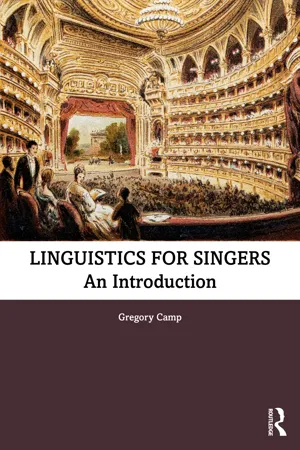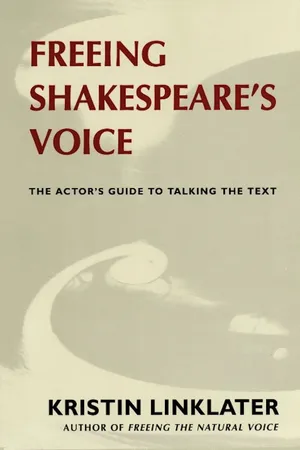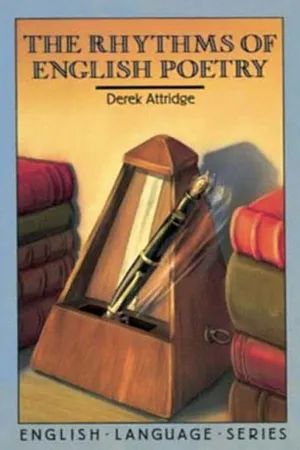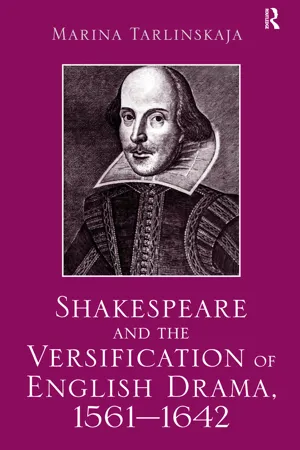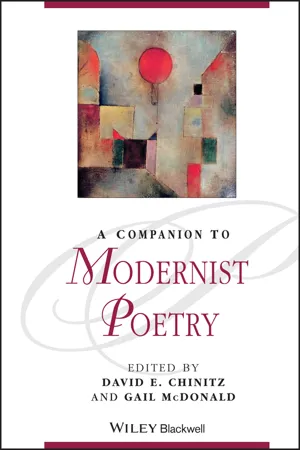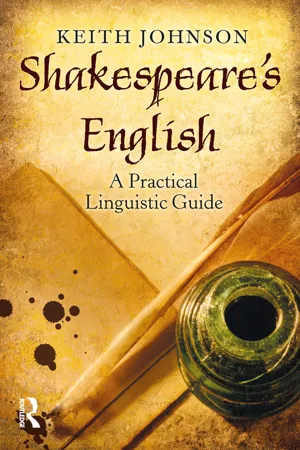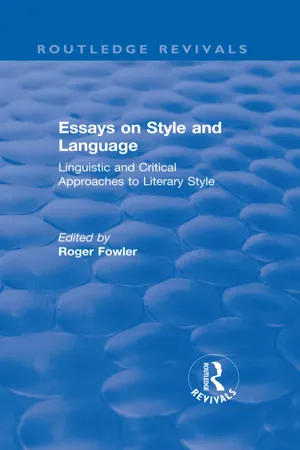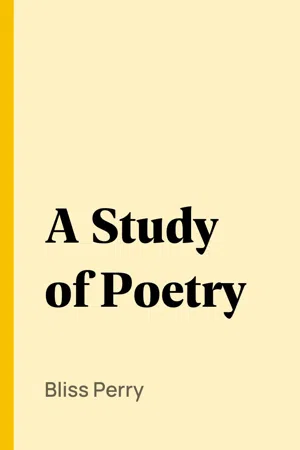Literature
Iambic Pentameter
Iambic pentameter is a poetic meter consisting of five metrical feet, with each foot containing an unstressed syllable followed by a stressed syllable (iambic). This rhythmic pattern is commonly used in English poetry and is known for its natural and flowing cadence. It has been widely employed by renowned poets, including William Shakespeare, in their works.
Written by Perlego with AI-assistance
11 Key excerpts on "Iambic Pentameter"
- eBook - ePub
Verse
An Introduction to Prosody
- Charles O. Hartman(Author)
- 2015(Publication Date)
- Wiley-Blackwell(Publisher)
iamb – a slack followed by a stress.The Names of Meters
The names of meters combine an adjective denoting the dominant kind of foot – such as “iambic” – with a noun that signifies a number (also in Greek!) with “-meter” added to it (because what we call a foot the Greeks sometimes called a “metron”). Here are all the nouns in use:
So “Iambic Pentameter” means a line of five iambs. In practice the extremes of length (1, 2, 8, 9) are rare.monometer mon-o-me-ter a line 1 foot long dimeter di-me-ter 2 feet trimeter tri-me-ter 3 feet tetrameter te-tra-me-ter 4 feet pentameter pen-ta-me-ter 5 feet hexameter hex-a-me-ter 6 feet heptameter hep-ta-me-ter 7 feet octameter oc-ta-me-ter 8 feet nonameter non-a-me-ter 9 feet Now that we’ve plunged into foreign vocabulary, a word about why we use it might be appropriate. This traditional terminology of feet isn’t the only way to analyze meter or metrical lines; it may not even be the most precise. (In Chapter 6 we’ll look at a couple of alternatives.) Its greatest advantage is that it is traditional: poets and readers have been using these terms for centuries, frequently thinking of and hearing lines as composed of these conventional units, and using these names when they want to discuss what goes on in a metrical line. Presumably an Iambic Pentameter that falls in the forest makes the same sound as one that has all its parts labeled, and it’s possible to feel the movement of the line like a dancer or hear it like a musician without knowing the terminology. But to discuss how we feel and hear the lines we read and write, some analytical tools like names are useful. These are the names that lie to hand.If all Iambic Pentameter lines were composed of five iambs, scanning them would be easy but there would be little point to it. In fact only a minority of Iambic Pentameters are exactly regular. There are two main kinds of variation. We’ll investigate “promoted stress” a little later. First we’ll discuss metrical substitution - eBook - ePub
Linguistics for Singers
An Introduction
- Gregory Camp(Author)
- 2023(Publication Date)
- Routledge(Publisher)
Doctor Faustus) are very regular, a textbook example of Iambic Pentameter:Is this the face that launched a thousand ships And burnt the topless tow’rs of Ilium?1 2 3 4 5 Is this the face that launched a thou- sand ships And burnt the top- less tow’rs ofI- li-;um? Shakespeare is famous for the flexibility of his verse; while it is overall iambic, it is not rigid. While it is almost always possible to stress the line as if it were, it would not sound at all natural. Let us take part of his most famous soliloquy:To be or not to be, that is the question, Whether ’tis nobler in the mind to suffer The slings and arrows of outrageous fortune, Or to take arms against a sea of troubles, And by opposing, end them? To die; to sleep …If stressed completely iambically, it would result in this:1 2 3 4 5 To be or not to be, that is the ques-tion,1 Whe- ther 'tis no- bler in the mind to suf-fer The slings and ar- rows of out-ra- geous for-tune, Or to take arms a-gainst a sea of trou-bles Or, by op-po- sing, end them? To die; to sleep Much of this does fit the pattern, but nobody would say whe- ther. That line would start with a stressed syllable: whe -ther ’tis no -bler in the mind to suf -fer. The end of the fifth line is clearly wrong: the stress needs to be on die and SLEEP - eBook - ePub
Freeing Shakespeare's Voice
The Actor's Guide to Talking the Text
- Kristin Linklater(Author)
- 1993(Publication Date)
- Theatre Communications Group(Publisher)
(weak strong).This is one “foot” of verse; one iamb.Why is it called a foot?Because such measures of rhythm were originated in the march melodies and dance melodies of Ancient Greece, and the foot comes down on the stressed beat. (Poetry, dance and music have been interrelated throughout the ages and the influences they have had upon each other are manifold.)What is a pentameter?A line of verse made up of five feet. The “pent” prefix means 5 (from Greek) and “meter” means “measure.” The Renaissance brought in a deep admiration for Greek and Latin classical literature, hence the adoption of the metrical terminology of those times. Monometer, Dimeter, Trimeter, Tetrameter, Pentameter, Hexameter mean 1, 2, 3, 4, 5 or 6 measures or feet in the line respectively.Why is the iambic rhythm the rhythm of the English language?I have no idea why it is, but I can help you observe that it is. This is not to say that we speak in steady iambic rhythm all the time but that the prevailing rhythm goes from an unaccented to an accented syllable. Within that prevailing rhythm all sorts of counterstresses elaborate the procedure.is strictly iambic. has a little extra weak beat in the second foot but the rhythm remains essentially iambic.How can I develop a feeling of this rhythm?Listen to your heartbeat when you have been exerting yourself, or listen to a baby’s heartbeat—it goesHow can I remember it?A well-known mnemonic for the Iambic Pentameter isDo I have to be able to count the five feet in an Iambic Pentameter?I would love to be able to say “No” but in all honesty I can’t. It takes time for some people to develop a feeling for the Iambic Pentameter but without it we have no check on whether we are using Shakespeare’s emphasis or our own. To know where the last strong stress comes in a given line is to know where the thought is driving. Thus it is important to find a way to count five iambic feet. I do it on the five fingers of one hand. - eBook - ePub
- Derek Attridge(Author)
- 2014(Publication Date)
- Routledge(Publisher)
This is not so, however, even within the literary tradition; while the four-beat line has often been used with this kind of variation (Coleridge’s ‘Christabel’ is perhaps the most self-conscious example), the pentameter has usually been distinguished by a more rigorous control of the number of syllables, its preference for duple rhythms and initial offbeats producing in strict metrical styles a count of ten, or eleven if a feminine ending is used, and only slightly more variety in freer styles. To understand this difference, we need to look a little more closely at the role of the syllable in the rhythms of English verse. While there are external reasons for the emphasis in different periods of literary history on a fixed syllable count, these cannot explain the success of this metrical principle in English; the achievements of Shakespeare, Spenser, Milton, and Wordsworth can hardly rest on a metre which is foreign to the language in which they wrote. It will be recalled that in Chapter 3 we found evidence for regarding the syllable as an elementary rhythmic unit of language, and it is likely, therefore, that apart from acting as the carrier of stress patterns and creating duple or triple rhythms, it can play a metrical role in its own right. The stress rhythm of English is too dominating for this role to be a major one, as it is in French verse, but we have already noted that the tendency towards isochrony in English is circumscribed by the rhythmic effect of the syllables between stresses - Marina Tarlinskaja(Author)
- 2016(Publication Date)
- Routledge(Publisher)
2 Syllabic prominence can be also achieved by the vowel quality, as in German, but English is first and foremost a stress language, not a quantity or quality language. All attempts to render quantitative meters literally into English had little success. Classical quantitative hexameters have been more often rendered into English as dactylic hexameters.Surrey, for the first time in English literature, composed his translation in what emerged as blank (unrhymed) Iambic Pentameters. The decasyllabic line of The Aeneid is much closer to Iambic Pentameter than to syllabic verse (see Table B.1 ): there is a sizeable contrast in stressing of even and odd syllables in the poem. The mean stressing of even (S) positions is 86.5 percent and of odd positions (W) 11.8, so the difference between mean S and mean W is 74.7 percent, quite large (Table B.1 ). In the undoubtedly iambic Kyd’s Spanish Tragedy the difference is 73.7 percent, very close to The Aeneid , while in John Donne’s Satyres , where iambic meter is moving towards a syllabic mode, the mean difference is only 46.0 percent. Judging by its stress profiles, The Aeneid is statistically not syllabic verse;3 it is still iambic, while Donne’s poetry in The Satyres is a transitional form (Tarlinskaja 1976, Chapter 8). However, as we shall find out below, the system of stressing in Late Middle English and Early New English differed from what we see today.Though statistically Surrey’s Aeneid is Early Modern English blank Iambic Pentameter, The Aeneid has been sometimes interpreted as syllabic verse. Why? Because certain lines are hard to fit into an iambic mold. O. B. Hardison writes: “Surrey appears to have understood his blank verse as a syllabic form” (Hardison 1989, p. 127). But Surrey’s goal must have been iambic verse form; that is why he rewrote Wyatt’s earlier translation of Petrarch’s Sonnet 140 , “Amor, che nel pensier mio vive e regna.” Surrey’s re-translation is much more iambic than Wyatt’s attempt that had puzzled many readers.4- eBook - ePub
- David E. Chinitz, Gail McDonald, Gail McDonald, David E. Chinitz(Authors)
- 2014(Publication Date)
- Wiley(Publisher)
Syllabics were and remain controversial, because they seem to remove poetry from the inherent qualities of spoken English, in which there is always emphasis: the standard argument against the form is that native speakers have no intuitive feeling for the number of syllables in a line. Against this, it has been asserted that one can learn to hear syllables; moreover it might be argued that poetry is always artificial, and that to impose a rule upon it which does not derive naturally from the language is to create the sort of artificial constraint that is necessary to art. One might also argue that syllabics create their own distinctive atmosphere, a subdued, reflective speech that would be much harder to achieve in even the most flexibly employed Iambic Pentameter.Reading Modern Rhythms
T. E. Hulme's “The Embankment,” a poem which Eliot presented as exemplary in his 1917 article, may be used to demonstrate both Eliot's account and its limitations:The opening line comes very close to being a line of iambic hexameter: if the reader chooses to give an artificial stress to the final syllable of “ecstasy,” it gains the extra stress; the inversion of the opening foot is a long-established device in the opening lines of Iambic Pentameter poems. The second line, the least regular in the poem, may be read with five stresses as marked above, and thus maintains continuity with the poem's other five-stress lines; but it is also possible to rush over “gold,” and thus give it four main stresses. In the first published text of the poem, the last two words had been “pavement grey,” a grammatical inversion that echoes W. B. Yeats's “The Lake Isle of Innisfree,” and created a more regular rhythm; the phrase was altered to “pavement hard” in a later version; only in the version printed in Ezra Pound's Ripostes (1912) did the rhythmically irregular form seen above make its appearance (Hulme 457).After the uncomplicated third line, the fourth line presents the reader with a choice in the pronunciation of “poesy” that is largely determined by what was done with “ecstasy” in the first line; the words have the potential to rhyme. The fifth line reasserts a regular iambic rhythm, and the sixth again poses problems: I have suggested that “star” and “eat-” are both given strong emphasis, but it would be possible to read “star-eaten” as a dactyl (stress-unstress-unstress): like other lines, this one permits both a four-stress and a five-stress reading. The final line is the most regular in the poem, though there is a degree of choice about how heavily “and” should be stressed. Assuming that it is stressed, we have a regular iambic hexameter line, and, if one subscribes to a conservative position about “simple” meters, the “comfort” described – albeit ironically – in the line is reinforced by the comforting return to metrical familiarity. - eBook - ePub
Shakespeare's English
A Practical Linguistic Guide
- Keith Johnson(Author)
- 2014(Publication Date)
- Routledge(Publisher)
Iambic or trochaic?) provides practice at identifying iambs and trochees in single disyllabic words.7.1.4 IPsSo, at long last, we have arrived at Shakespeare, and the ‘iambic’ part of the IP formula. Look now in detail at the Henry V passage (e) in Activity 1. The lines were chosen because they well illustrate sequences of iambs, as you will discover if you mark the stress sequence in the same way as you did for the limerick in part (ii) of Activity 5. The lines also well illustrate that to make the lines entirely regular you have to be prepared to exaggerate a little – to read them with a certain lilt, sometimes stressing syllables that would otherwise take secondary stress or even no stress at all, at other times not giving due stress on a content word where you otherwise might expect it. In the first line, for example, your ‘lilting’ read might put more stress on the to in unto than in usual speech. But with these little adjustments, the underlying regularity of the metre is apparent:Once more unto the breach, dear friends, once morex/x/x/x/x/So here we have a sequence of iambs. But there is another sort of regularity which is apparent in these lines. It is that the number of stresses per line is five. Hence the word pentameter , from the Ancient Greek pente meaning five. The lines are Iambic Pentameters. We have arrived! In order to develop a stronger feel for the IP, try DeDUMming the lines – saying De for an unstressed syllable, DUM for a stressed. So Once more unto the breach, dear friends, once more becomes DeDUM deDUM deDUM, deDUM, deDUM.In a moment we shall be looking at ways in which Shakespeare often deviates from strict IPs. Before we do this, it is important to gain a feeling for the regular IPs that pervade his work. Take a look at Texts 1–3 on the Text Page. They are passages predominantly written in IPs, taken from different periods of Shakespeare’s writing life. Read through these passages now to develop a sense of what IPs are like. - eBook - ePub
The Princeton Encyclopedia of Poetry and Poetics
Fourth Edition
- Stephen Cushman, Clare Cavanagh, Jahan Ramazani, Paul Rouzer, Stephen Cushman, Clare Cavanagh, Jahan Ramazani, Paul Rouzer(Authors)
- 2012(Publication Date)
- Princeton University Press(Publisher)
Analysis of poetic modes comes generally after the fact, but in every period, prosodic crit. has a moralistic flavor, with many critics and poets disdaining their predecessors: e.g., 19th-c. poets, such as John Keats and Matthew Arnold, sometimes dismissed their Augustan precursors as writers of mere prose. Inconclusive debate has always attended the effort to relate prosody to meaning. Pope’s famous dictum that “the sound should seem an echo to the sense,” illustrated with his lines about “swift Camilla,” represents one side of the case; the other is taken by Johnson, who (also famously) dismisses the general applicability of the contention. In various periods, poets, critics, and readers have sensed a semiotic function of prosody without being able to generalize persuasively about it. The regular pentameter line and the internal aural challenges to it represent a wider contest between order and individuality, and in the 20th c., the failure of traditional forms often signifies personal and social collapse. Some feminist critics have identified traditional meter with the restrictions of patriarchal control: Emily Dickinson, e.g., is said to have mostly avoided Iambic Pentameter as connoting the forces of Father and Christianity. But there is little agreement on such an iconic function of prosody.SeeALLITERATION ; ENGLAND, POETRY OF ; FREE VERSE ; HEROIC VERSE ; RHYTHM ; SOUND ; STANZA ; VERSIFICATION.Old English: Sievers; M. Kaluza, A Short History of English Versification (1911); J. C. Pope, The Rhythm of “Beowulf,” 2d ed. (1966); A. J. Bliss, The Metre of “Beowulf,” 2d ed. (1967); T. Cable, The Meter and Melody of “Beowulf” (1974); Brogan, sect. K; G. Russom, Old English Meter and Linguistic Theory (1987); W. Obst, Der Rhythmus des “Beowulf” (1987); R. D. Fulk, A History of Old English Meter (1992); B. R. Hutcheson, Old English Poetic Metre (1995); S. Suzuki, The Metrical Organization of “Beowulf” (1996); T. A. Bredehoft, Early English Metre (2005).Middle English: General:Schipper; K. Luick Englische Metrik (1893); B. Ten Brink, The Language and Metre of Chaucer (1920); J. P. Oakden, Alliterative Poetry in Middle English , 2 v. (1930–35); A. McI. Trounce, “The English Tail-Rhyme Romances,” Medium Ævum 1–2 (1932–34); F. Pyle, “The Place of Anglo-Norman in the History of English Versification,” Hermathena 49 (1935); P. F. Baum, Chaucer’s Verse (1961); M. Borroff, “Sir Gawain and the Green Knight”: A Metrical and Stylistic Study (1962); M. D. Legge, Anglo-Norman Literature and Its Background (1963); Pearsall; Brogan, sect. K; U. Fries, Einführung in die Sprache Chaucers (1985); A.V. C. Schmidt, The Clerkly Maker (1987); M. Tarlinskaja, Strict Stress-Meter in English Poetry (1993). Alliterative Revival: J. R. Hulbert, “A Hypothesis Concerning the Alliterative Revival,” MP 28 (1930); R. A. Waldron, “Oral-Formulaic Technique and Middle English Alliterative Poetry,” Speculum 32 (1957); E. Salter, “The Alliterative Revival,” MP 64 (1966–67); T. Turville-Petre, The Alliterative Revival (1977); A. McIntosh, “Early Middle English Alliterative Verse,” and D. Pearsall, “The Alliterative Revival,” Middle English Alliterative Poetry , ed. D. A. Lawton (1982); H. Duggan, “The Shape of the B-Verse in Middle English Alliterative Poetry,” Speculum 61 (1986); T. Cable, The English Alliterative Tradition (1991); R. Hanna, “Alliterative Poetry,” Cambridge History of Medieval English Literature , ed. D. Wallace (1999); C. Chism, Alliterative Revivals (2002); H. Zimmerman, “Continuity and Innovation: Scholarship on the Middle English Alliterative Revival,” Jahrbuch für Internationale Germanistik 35 (2003); A. Putter, J. Jefferson, and M. Stokes, Studies in the Metre of Alliterative Verse (2007); N. Yakovlev, “Prosodic Restrictions on the Short Dip in Late Middle English Alliterative Verse,” YLS - eBook - ePub
Routledge Revivals: Essays on Style and Language (1966)
Linguistic and Critical Approaches to Literary Style
- Roger Fowler(Author)
- 2017(Publication Date)
- Routledge(Publisher)
What we hear in an Iambic Pentameter depends on one of the mass of relations within poetic form: that between two competing phonological structures. One is the metre: a skeleton with a few regularly proportioned and articulated parts. It is built up on the basis of one unit, the foot; five feet form a line; lines may be grouped into sets (‘couplets’, ‘stanzas’, etc.) by rhyme. These three units—foot, line and stanza—are identified by phonetic characteristics. The foot has a light followed by a heavy stress; within the line, all light and heavy stresses are equated, giving only two grades of stress. The line is marked off, not only by the number of feet, stresses and syllables it contains, but by certain terminal sound-features: perhaps by a pause, but more probably by a prolongation of its last vowel and/or voiced consonant; often by a change in the pitch of the voice. The stanza is identified by its rhyme-scheme and often by a fall in the pitch of the voice at the end. Some other minor conventions govern the form of the pentameter: for example, the light and heavy stresses of the first foot may be reversed (but not too often); the stresses of the second foot may not.This metrical skeleton has to be filled out by linguistic elements—grammatical and lexical units—which have their own expectations of phonological form: ‘prose rhythm’, the second of the structures I have referred to. English grammar, like English pentameter metre, has a scale of units of different ‘sizes’: morpheme, word, phrase, clause, sentence, in ascending order of magnitude. These units of grammar have their own stress-patterns which—and this is the whole point of this essay—may or may not correspond with those of the metrical matrix that they are made to occupy. The ends of sentences are inevitably marked by a change in the pitch of the voice; no matter how this is interpreted by different performers, it must occur in some form. Now the sentence is a unit of great variation in length, so the ‘terminal juncture’, as the end-marker is called, may or may not fall in the same places as the natural terminal junctures of the metre: at line- and stanza-ends. The smallest unit in the metre is the metrical point: it is always′ or× ; any two in sequence are likely to be different; the order in which they combine to make up a foot is almost always× ′. The smallest unit in the grammar is the morpheme. It is most often a monosyllable, and may have any one of four stresses:’, ^, ′, or ˇ in descending order of loudness.3 The selection depends on the adjacent stresses, and these in turn are governed chiefly by the grammatical construction in which the morpheme occurs. Greenfly has”; green fly ˆ ’ apart ˇ ’ -itab - in inevitable ’ˆ - eBook - ePub
- Bliss Perry(Author)
- 2005(Publication Date)
- Perlego(Publisher)
aa. The familiar measure of English ballad poetry,"The King has written a braid letter, And signed it wi' his hand, And sent it to Sir Patrick Spence, Was walking on the sand"is alternating four-stress and three-stress iambic, rhyming ab cb. The In Memoriam stanza,"Now rings the woodland loud and long, The distance takes a lovelier hue, And drown'd in yonder living blue The lark becomes a sightless song"is four-stress iambic, rhyming ab ba.The Chaucerian stanza rhymes a b a b b c c:"'Loke up, I seye, and telle me what she is Anon, that I may gone aboute thi nede: Know iche hire ought? for my love telle me this; Thanne wolde I hopen the rather for to spede.' Tho gan the veyne of Troilus to blede, For he was hit, and wex alle rede for schame; 'Aha!' quod Pandare, 'here bygynneth game.'"Byron's "ottava rima" rhymes a b a b a b c c:"A mighty mass of brick, and smoke, and shipping, Dirty and dusky, but as wide as eye Could reach, with here and there a sail just skipping In sight, then lost amidst the forestry Of masts; a wilderness of steeples peeping On tiptoe through their sea-coal canopy; A huge, dun cupola, like a foolscap crown On a fool's head—and there is London Town!"The Spenserian stanza rhymes a b a b b c b c c, with an extra foot in the final line:"Hee had a faire companion of his way, A goodly lady clad in scarlot red, Purfled with gold and pearle of rich assay; And like a Persian mitre on her hed Shee wore, with crowns and owches garnished, The which her lavish lovers to her gave: Her wanton palfrey all was overspred With tinsell trappings, woven like a wave, Whose bridle rung with golden bels and bosses brave."In considering these various groups of lines which we call stanzas it is clear that we have to do with thought-units as well as feeling-units, and that both thought-units and feeling-units should be harmonized, if possible, with the demands of beauty and variety of sound as represented by the rhymes. It is not absurd to speak of the natural "size" of poetic thoughts. Pope, for instance, often works with ideas of couplet size, just as Martial sometimes amused himself with ideas of a still smaller epigram size, or Omar Khayyam with thoughts and fancies that came in quatrain sizes. Many sonnets fail of effectiveness because the contained thought is too scanty or too full to receive adequate expression in the fourteen lines demanded by the traditional sonnet form. They are sometimes only quatrain ideas, blown up big with words to fill out the fourteen lines, or, on the contrary, as often with the Elizabethans, they are whole odes or elegies, remorselessly packed into the fashionable fourteen-line limit. No one who has given attention to the normal length of phrases and sentences doubts that there are natural "breathfuls" of words corresponding to the units of ideas; and when ideas are organized by emotion, there are waves, gusts, or ripples of words, matching the waves of feeling. In the ideal poetic "pattern," these waves of idea, feeling and rhythmic speech would coincide more or less completely; we should have a union of "emotional law" with "stanzaic law," the soul of poetry would find its perfect embodiment. - eBook - ePub
Meter in English
A Critical Engagement
- David Baker(Author)
- 1997(Publication Date)
- University of Arkansas Press(Publisher)
Ever creative, the present spins the future out of the past. In one of his colloquies Goethe spoke of “the abyss of the seed,” its endless depths of history and futurity. At this moment in the late twentieth century, we are already at work on our new poetry. Its seeds are long sown. The flood of flaccid free verse has truly come to bore and irritate us, just as the mountains of metrical sentiments irritated our forebears when the century turned. We cannot yet consciously hear the new music, the great poetry of the twenty-first century. We can say that we are postmodern, but we can’t say precisely what we are pre-, on the verge of. What is clear, I believe, is that we need all of the poetic resources of the past and the present in order to imagine, listen for, and delight in the poetry of coming generations. What we need is not to limit but rather to welcome and legitimize these various resources.In a time of relative metrical ignorance on the part of most younger readers and writers, the project of paying close attention to the resource of meter is even more important than a similar attention to the full spectrum of rhyme. What the layperson often asks about a poem is “Does it rhyme?” But what he also means to ask about—what engages his visceral response in the first line and a half, before the rhyme appears, or doesn’t—is rhythm, the music that the language plays on the instrument of his body even before the sentence is complete and his mind has made full sense of the words. However, he has still asked the right question, for rhyme and meter are both recurring patterns, and what he wants to know is “What kind of universe we are inhabiting in this poem?” Is it a universe that the Newtonian mind identifies as orderly, or is it some newfangled quantum chaos spawned in a primal soup prior to narrative, tonality, and recognizable objects?One of the possible universes a poem might offer us is suggested in an early and fundamental contention in Bob Wallace’s essay that is not by itself singled out for discussion. In the penultimate paragraph of part 1 of “Meter in English,” Wallace says, “This meter, accentual-syllabic, as described, is [his emphasis] English meter. There is no other” (10). He reiterates this position in the closing of part 2 : “There is one meter in English: accentual-syllabic, and its base is always iambic” (22). With so much else in our minds and libraries, we have to think hard what he means by these statements. A good half of the propositions Wallace offers are based on his premise that iambic accentual-syllabic meter is all there is and ever will be in English meter. Certainly a vast majority of English-language poems, and surely many of the best of them, have been accentual-syllabic, and these have been predominantly iambic. But to claim that this is the only meter that exists in English, and that its base is always iambic, seems to me both untrue and unnecessarily limiting. This is not economy for the sake of clarity; this is a defense of canonical meter to the exclusion of all else. One might wish for tolerance, at least, of marginal meters as quarters of possible surprise. We should not be narrowing the word “meter” to make it a synonym for “iambics” but rather broadening our understanding of meter’s exciting developments in this century. We should be urging recognition of how splendidly diverse, instead of how “splendidly unitary” English meter is (30). Why should we welcome anything less than all
Index pages curate the most relevant extracts from our library of academic textbooks. They’ve been created using an in-house natural language model (NLM), each adding context and meaning to key research topics.
Explore more topic indexes
Explore more topic indexes
1 of 6
Explore more topic indexes
1 of 4

